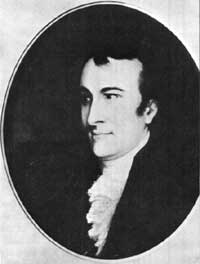







Biographical Sketches
|
THOMAS STONE Maryland |
 Thomas Stone | |
| ||
Stone was born in 1743 at Poynton Manor, his father's plantation near the village of Welcome in Charles County, Md. He enjoyed all the advantages that accrued to the eldest son. Following tutorial instruction in the classics as a youth, he apprenticed himself to an Annapolis lawyer and in 1764 joined the bar. For the first 2 years he practiced at Frederick, Md., and then settled in his home county. He married 2 years later. Apparently with part of his wife's dowry, he purchased land a few miles to the northeast of his birthplace. There, near Port Tobacco, in 1771 he built Habre-de-Venture, his home and principal residence for the rest of his life.
Stone entered politics in 1773 as a member of the Charles County committee of correspondence. The next year, on behalf of the Proprietary Governor, he helped prosecute Joseph H. Harrison, a Maryland legislator who had refused to pay the poll tax for the support of the Anglican clergy. This action, despite its legal ethicality, did not endear Stone to the patriots. His opponents, counsel for the defense, consisted of Thomas Johnson, Samuel Chase, and William Paca—all three of whom later became his congressional colleagues.
That same year, 1774, Stone won appointment to the provincial convention, which the following year sent him to Congress. A far less enthusiastic Revolutionary than most Congressmen, he heartily favored reconciliation almost up to the time of the vote on independence and was one of the few Delegates who favored peace negotiations with Britisher Lord Richard Howe in September 1776, some 2 months after the adoption of the Declaration. A poor speaker, Stone rarely participated in debates but sat on the committee that drafted the Articles of Confederation, though he did not sign the document. He remained in Congress until 1778.
Meantime, a couple of years earlier, Stone had begun a tour in the State senate that was to last for practically the remainder of his life. In 1784 he also returned to the Continental Congress, where he served for a few days as acting President but resigned before the year expired to resume his law practice. His last act of public service occurred the following year, when he and two others represented Maryland at the Mount Vernon Conference.
In 1787 Stone's wife, whose health had been failing for more than a decade, passed away at the age of 34. The grief-stricken Stone abandoned his work, declined to attend the Constitutional Convention to which he had been elected, and decided to visit England. A few months later, though only in his mid-forties, he died suddenly while awaiting a vessel at Alexandria, Va. Three of his children survived him. Stone is buried in the family graveyard adjacent to Habre-de-Venture.
Drawing: Library of Congress.
 |
 |
http://www.cr.nps.gov/history/online_books/declaration/bio47.htm
Last Updated: 04-Jul-2004